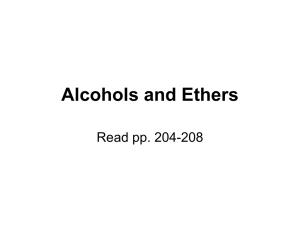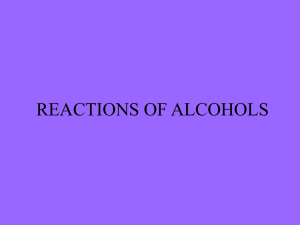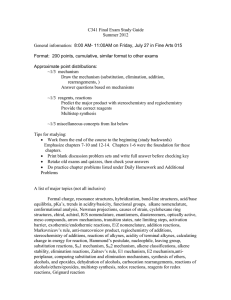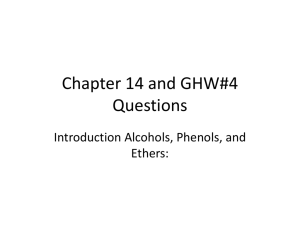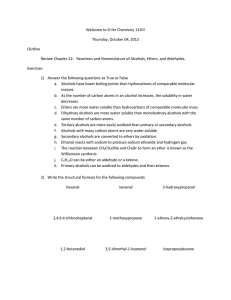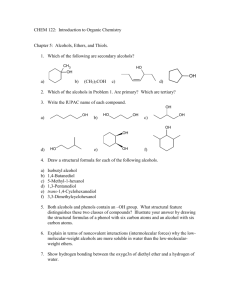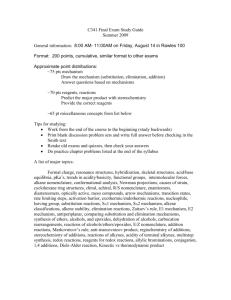SCH 4U Organic Day 6 Alcohols and Ethers Assignment
advertisement
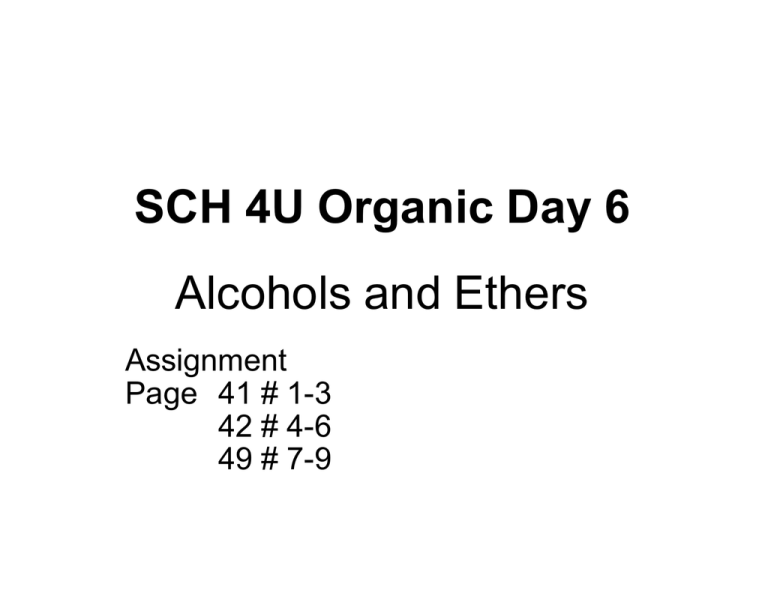
SCH 4U Organic Day 6 Alcohols and Ethers Assignment Page 41 # 1-3 42 # 4-6 49 # 7-9 Compounds with Oxygen Atoms Alcohols -OH hydroxyl CH3-OH CH3CH2-OH OH OH Phenols Ethers -O- CH3-O-CH 3 Alcohols and Ether Naming Alcohols n A carbon compound that contain -OH (hydroxyl) group n In IUPAC name, the -e in alkane name is replaced with -ol. CH4 methane CH3OH methanol (methyl alcohol) CH 3CH 3 ethane CH 3CH2OH ethanol (ethyl alcohol ) More Names of Alcohols n IUPAC names for longer chains number the chain from the end nearest the -OH group. CH 3CH 2CH 2OH 1-propanol OH CH3CHCH 3 CH3 2-propanol OH CH 3CHCH 2CH2CHCH 3 5-methyl-2-hexanol IUPAC Substitutive Nomenclature An IUPAC name may have up to 4 features: locants, prefixes, parent compound and suffixes Numbering generally starts from the end of the chain which is closest to the group named in the suffix Double bonds and alcohols Alkenols P The hydroxyl has highest priority (so far) P -OH is given the lowest possible number Double bonds and alcohols Alkenols 1 2 3 Classification of Alcohols Primary (1º) H Secondary (2º ) CH3 CH 3-C-OH CH 3-C-OH H H 1C attached to C-OH 2C attached to C-OH Tertiary (3º) CH 3 CH 3-C-OH CH 3 3C attached to C-OH l 3o alcohols are much less reactive than 1o or 2o alcohols in oxidation reactions. Some Typical Alcohols OH “rubbing alcohol” CH3CHCH3 2-propanol (isopropyl alcohol) antifreeze HO-CH2-CH2-OH 1,2-ethanediol (ethylene glycol) OH glycerol HO-CH2-CH-CH2OH 1,2,3-propanetriol Phenols l IUPAC name for benzene with a hydroxyl group OH l Many are used as antiseptics and disinfectants Phenol Phenols in Medicine OH OH OH OH OH CH2CH2CH2CH2CH2CH3 Phenol Resorcinol (antiseptic) 4-Hexylresorcinal (antiseptic) Ethers • Contain an -O- between two carbon groups • Simple ethers named from -yl names of the attached groups and adding ether. CH 3-O-CH3 dimethyl ether (methoxymethane) CH 3-O-CH2CH3 ethyl methyl ether (methoxyethane) IUPAC Naming of Ethers Identify the smaller chain attached to the -OName this alkyl as a prefix, change the -yl to -oxy Name the longer chain on -oxy as suffix CH3-O-CH 3 methoxymethane CH 3-O-CH2 CH 3 methoxyethane Ethers as Anesthetics l Anesthetics inhibit pain signals to the brain l CH3CH2-O-CH2CH3 used for over a century (Morton, 1846) l Causes nausea and is highly flammable l 1960s developed nonflammable anesthetics Cl F F Cl F H H-C-C-O-C-H F F F Ethane(enflurane) H-C-C-O-C-H HF H Penthrane Alcohol functional groups are polar Hydrogen bonding is possible (like water) The more red an area is, the higher the electron density and the more blue an area is, the lower the electron density. The hydroxyl O atom is a region of high electron density (red) due to the lone pairs. Physical Properties of Alcohols (R-OH) P Molecules of alcohols can hydrogen bond to each other P Alcohols have considerably higher boiling points than ethers Physical Properties of Ethers (R-O-R’) P Molecules of ethers cannot hydrogen bond to each other (no H attached to O) P Ether boiling points are similar to hydrocarbons of the same molecular weight P Ethers form dipole-dipole attractions P Small carbon chain ethers are soluble in water Dehydration of Alcohols P Alcohols can be made by addition of water to alkenes P Alkenes can be made by dehydration of alcohols P Tertiary alcohols are easier to dehydrate than primary alcohols Synthesis of Ethers P Primary alcohols dehydrate to produce ethers at low temperatures P Alcohols dehydrate to produce alkenes at higher temperatures P 2o and 3o alcohols form alkenes more than ethers Learning Check Al1 Classify each as an alcohol (1), phenol (2), or an ether (3): A. _____ CH 3CH2-O-CH3 OH B. _____ CH3 C. _____ CH 3CH2OH Solution Al 1 Classify each as an alcohol (1), phenol (2), or an ether (3): A. __3__ CH 3CH2-O-CH3 OH B. _ 2__ CH3 C. __1__ CH3CH2OH Learning Check Al 2 Name the following alcohols: A. OH CH3CHCHCH 2CH3 CH3 OH B. Solution Al 2 Name the following alcohols: A. OH CH3CHCHCH 2CH3 3-methyl-2-pentanol CH 3 OH B. cyclobutanol
